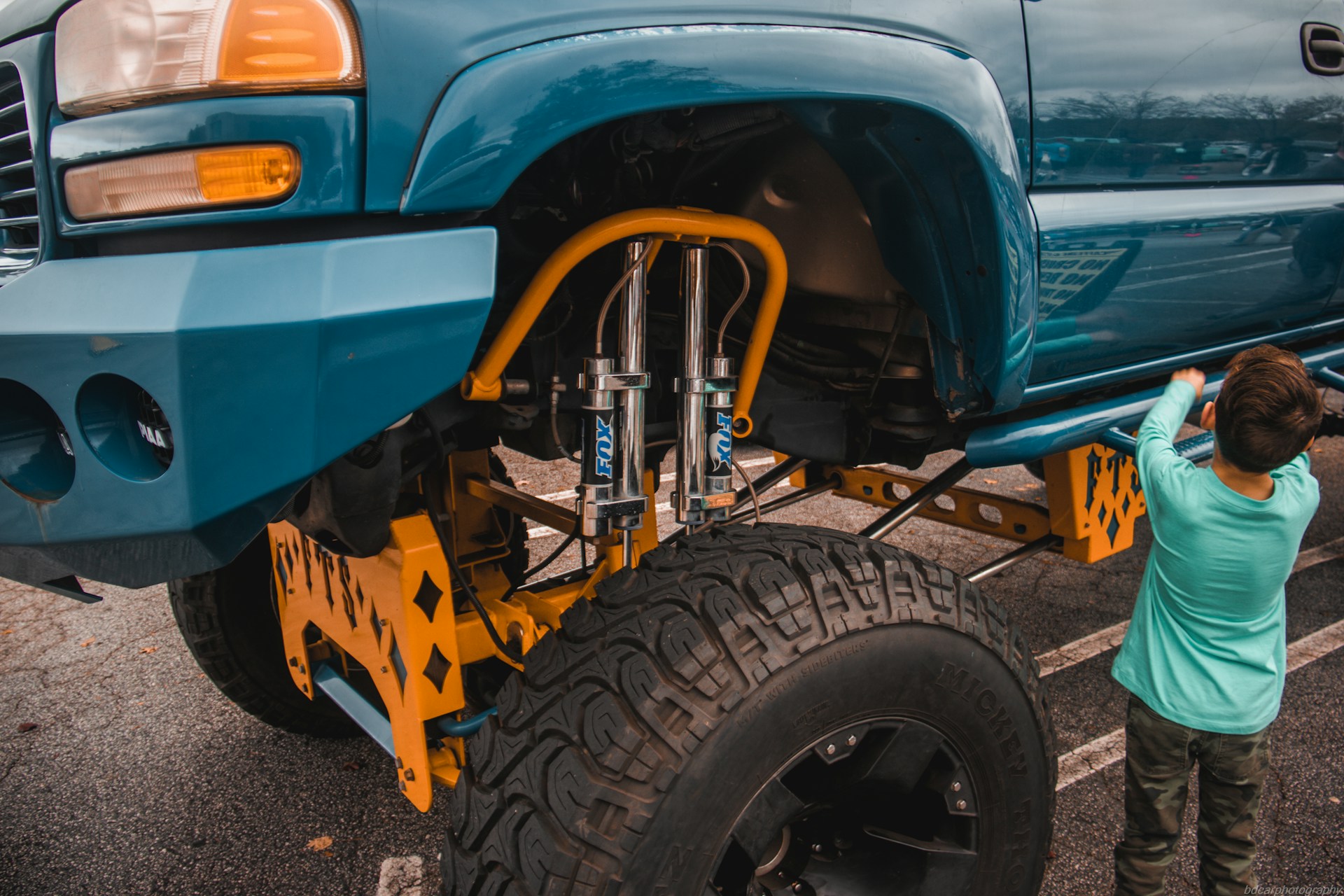Got a flat tire on your truck? This guide outlines ten essential steps to change a truck tire, ensuring you’re back on the road safely. Ideal for roadside emergencies or garage maintenance, these steps help you swap heavy truck tires confidently, keeping your vehicle ready for any job.
1. Gather Tools and Spare Tire
Before changing a truck tire, collect the necessary tools and a spare tire. Trucks require robust equipment due to their larger, heavier wheels, ensuring a smooth process.
Having the right tools and a compatible spare is critical. Here’s what you need to start.
-
Get a spare tire. Ensure you have a matching spare tire ($100-$300) for your truck’s rim size, typically 16-20 inches.
-
Use a heavy-duty jack. A floor jack or bottle jack ($30-$150) rated for your truck’s weight is essential.
-
Grab a lug wrench. A heavy-duty lug wrench or impact wrench ($20-$100) handles larger truck lug nuts.
-
Have a tire pressure gauge. A gauge ($5-$20) checks the spare’s pressure for safe driving.
2. Park on a Safe, Flat Surface
Park the truck on a flat, stable surface to ensure safety during the tire change. This prevents rolling or tipping, especially critical for heavy trucks.
A level roadside shoulder or garage floor is ideal. Here’s how to set up safely.
-
Choose a flat area. Park on a paved shoulder or garage floor to keep the truck steady.
-
Engage the parking brake. Set the brake firmly to prevent movement during the tire change.
-
Turn on hazard lights. Activate lights to alert other drivers if changing roadside, enhancing safety.
-
Use wheel chocks. Place chocks or heavy objects ($0-$20) around opposite wheels for added stability.
3. Loosen the Lug Nuts
Loosen the lug nuts on the flat tire before lifting the truck. Truck lug nuts are often tighter and larger, requiring extra effort or tools.
Do this on the ground to avoid wheel spin. Here’s how to loosen the nuts.
-
Use a lug wrench. Fit a heavy-duty wrench onto each nut and turn counterclockwise, costing $0 if included.
-
Apply strong pressure. Use body weight or a breaker bar for tight nuts, taking 2-4 minutes.
-
Follow a star pattern. Loosen nuts in a crisscross order to release pressure evenly, preventing wheel damage.
-
Keep nuts safe. Store lug nuts in a container to avoid losing them during the process.
4. Lift the Truck Safely
Lift the truck with a heavy-duty jack to access the flat tire. Proper jack placement is crucial for handling the truck’s weight and ensuring stability.
Correct positioning prevents frame damage or tipping. Here’s how to lift the truck.
-
Locate the jack point. Find the reinforced frame or axle near the flat tire, per the owner’s manual.
-
Position the jack. Place a heavy-duty jack under the frame, ensuring stability, costing $0 if included.
-
Raise the truck. Crank or pump the jack until the tire is 2-3 inches off the ground, taking 3-5 minutes.
-
Check stability. Ensure the truck is steady to avoid accidents during tire removal.
5. Remove the Wheel
Remove the wheel with the flat tire to access the tire for replacement. This involves fully unscrewing the lug nuts and handling the heavy wheel.
Careful removal ensures a smooth process. Here’s how to take off the wheel.
-
Unscrew lug nuts. Fully remove the loosened nuts with the lug wrench, placing them in a safe spot.
-
Pull off the wheel. Grip the wheel firmly and slide it off the axle, taking 1-2 minutes, due to its weight.
-
Set the wheel flat. Lay it on the ground to prevent rolling, keeping the workspace clear.
-
Inspect the hub. Clear debris from the hub to ensure a clean remounting later.
6. Check the Spare Tire
Before mounting, verify the spare tire’s condition and compatibility. Truck spares are often full-size but may need pressure or condition checks.
Ensuring the spare is ready prevents issues after installation. Here’s how to check it.
-
Inspect for damage. Check the spare for cuts or wear, ensuring it’s roadworthy, costing $100-$300 if replaced.
-
Check pressure. Use a gauge ($5-$20) to confirm 30-35 PSI, per the truck’s manual, taking 1-2 minutes.
-
Verify rim size. Ensure the spare matches your truck’s rim size, typically 16-20 inches.
-
Inflate if needed. Use a pump ($10-$50) to adjust pressure before mounting for safety.
7. Mount the Spare Tire
Mount the spare tire onto the truck’s axle to replace the flat. Truck tires are heavier, requiring careful alignment and strength for secure mounting.
Proper technique ensures a safe fit. Here’s how to install the spare tire.
-
Lift the spare. Align the spare’s holes with the axle studs, pushing it into place, taking 2-3 minutes.
-
Hand-tighten lug nuts. Screw nuts on by hand in a star pattern to hold the tire, costing $0.
-
Ensure proper seating. Check that the tire sits flush against the hub to avoid wobbling.
-
Work with care. Use a partner for heavy tires to prevent strain or dropping the wheel.
8. Lower the Truck Safely
Lower the truck back to the ground after mounting the spare. Careful lowering prevents sudden drops and ensures the wheel is secure.
Using the jack properly maintains safety. Here’s how to lower the truck.
-
Lower the jack slowly. Turn or release the jack to bring the truck down gently, taking 2-3 minutes.
-
Ensure tire contact. Lower until the spare fully touches the ground, bearing the truck’s weight.
-
Remove the jack. Slide the jack out carefully once the truck is stable, costing $0.
-
Check stability. Confirm the truck is steady and the tire is secure before proceeding.
9. Tighten the Lug Nuts
Fully tighten the lug nuts after lowering the truck to secure the spare tire. Truck lug nuts require strong torque for safety on heavy vehicles.
Proper tightening prevents wheel detachment. Here’s how to tighten the nuts.
-
Use a star pattern. Tighten nuts with a lug wrench in a crisscross order, taking 2-3 minutes.
-
Apply firm torque. Use body weight or an impact wrench ($50-$100) for secure tightening.
-
Check tightness. Ensure nuts are snug to prevent wobbling, costing $0 for DIY.
-
Recheck after driving. After 50 miles, retighten nuts to confirm security, ensuring safety.
10. Test and Clean Up
Test the new tire and clean up your workspace to complete the process. This ensures the tire is secure and the truck is ready for use.
Testing and cleanup finalize a successful tire change. Here’s how to wrap up.
-
Test drive the truck. Drive briefly to confirm the wheel is secure, checking for vibrations, taking 2-3 minutes.
-
Check tire pressure. Verify 30-35 PSI with a gauge ($5-$20) after installation, adjusting if needed.
-
Store tools and flat tire. Return the jack and wrench to storage and secure the flat, taking 2-3 minutes.
-
Plan for repair. Take the flat tire to a shop for repair or replacement, costing $20-$200.
Conclusion
Changing a truck tire is manageable with these ten steps, from gathering tools to testing the spare. Tackle flats confidently for any haul. For expert help, our highly professional and fast mobile tire change service connects you to trusted tire professionals 24/7. Keep your truck road-ready with ease!







